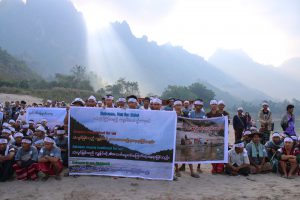The question of how developing countries can harness responsible foreign investment to meet the needs of citizens in an equitable and environmentally sustainable manner is not unique to those in Latin America, according to Jin Jiaman, director of Chinese NGO Global Environmental Institute (GEI). It is also highly relevant in Africa and South East Asia.
Nonetheless, China’s commitment of over US$120 billion of investment in energy and infrastructure in Latin America in the past decade should be monitored by both Chinese and host country NGOs to ensure that it meets the highest environmental standards, Jin said at an event co-organised by Diálogo Chino and the London School of Economics’ Global South Unit on Wednesday.
By working together to monitor impacts such as deforestation, civil society organisations can provide information that leads to improvements in environmental governance, which can be applied to Chinese trade and investment.
GEI is one of the few Chinese NGOs that works with Chinese companies overseas. The organisation’s research on illegal logging with local partners in Myanmar identified previously unknown smuggling routes along the border with China, enabling authorities to better enforce the law.
However, financial constraints on Chinese NGOs mean operating in regions as distant as Latin America remains a challenging proposition. This is despite an urgent need to work collaboratively to improve Chinese companies’ understanding of local concerns over their operations in the region, Jin said.
Soya impacts
Within the first five months of 2016, Brazil has exported 14 billion tonnes of soybeans to China and this figure is expected to double by 2020.
Though this booming trade has made soya farmers rich in Brazil and Argentina, the effects on soil pollution (often from pesticide overuse) and its links with deforestation will cost Brazil an inordinate amount in the long term, Jin said.
Driven by a mixture of strategic food security concerns and market opportunities, Chinese companies are investing in the acquisition of huge multinational grain dealers. But the enormous volumes of grain grown and traded and the impacts this has on Latin America’s forests and arable land necessitates that the industry be served by sustainable supply chains with strong environmental standards, Jin said. She added that the implementation of robust standards is crucial.
Click here to listen to a podcast of the event
Learning process
As a relatively new frontier for Chinese outbound investment, Latin America presents a distinct operating environment for companies and investors – one where engagement with a variety of stakeholders on a project’s impacts is recommended.
Chinese companies have begun to dispel the notion that disputes can be resolved by local political elites and are becoming more sensitive to local social and political realities. As ever, it should also be noted that many Western firms operating in Latin America also have a long way to go to improve their practices.
In Honduras, Chinese dam-builder Sinohydro was among the first stakeholders to withdraw from the controversial Aguas Zarca hydroelectric project. The company withdrew in 2010 as suppression of opposition to the project by Honduran authorities turned increasingly violent. Yet it was not until after the murders of high profile activist Berta Caceres and colleague Nelson Garcia that Dutch and Finnish investors pulled out.
Ongoing conflict at the China Minmetals (MMG)-owned Las Bambas mine in Apurimac, Peru, recently claimed the life of farmer Quintina Cerecedo Huisa, who was shot by police as protests again erupted over the use of a communal road to transport copper concentrates. Use of the road by MMG was not outlined in the project’s original environmental and social impact assessment (ESIA).
After fatal protests last year, Cerecedo is the fourth person to die opposing use of the road by the mine but the first at one of Peru’s 145 unresolved mining conflicts under new president Pedro Pablo Kuczynski. It’s yet another painful reminder to all companies, irrespective of nationality, of the need to work with local communities on the impacts of projects.
Studies by the Universidad del Pacífico have shown that Chinese companies operating in Peru’s mining sector do not necessarily score any lower in terms of their environmental performance when compared to international counterparts.
The Toromocho mine, where new mine owner Chalco relocated an entire town and employed Peruvian consultants to manage the move in consultation with the local community, is cited as a positive example of a Chinese company new to the region being careful to avoid past mistakes.
By partnering with local civil society groups, Chinese NGOs can expedite the learning process that companies are already undergoing in the region. In doing so, they can also promote a race to the top in terms of social and environmental standards, Jin said, and can play a major role in contributing to socially and environmentally responsible growth.








